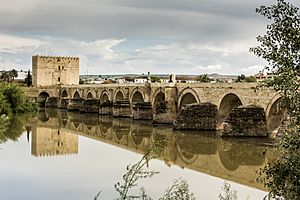Roman bridge of Córdoba facts for kids
Quick facts for kids Roman bridge of Córdoba |
|
|---|---|
 |
|
| Coordinates | 37°52′36″N 04°46′41″W / 37.87667°N 4.77806°W |
| Carries | Pedestrians and bicycles (since 2004) |
| Crosses | Guadalquivir |
| Locale | Córdoba, Spain |
| Next upstream | Miraflores Bridge |
| Next downstream | San Rafael Bridge |
| Characteristics | |
| Design | Arch bridge |
| Total length | 331 m (1,086 ft) |
| Width | 9 m (30 ft) |
| UNESCO World Heritage Site | |
| Part of | Historic centre of Córdoba |
| Criteria | Cultural: (i), (ii), (iii), (iv) |
| Inscription | 1984 (8th Session) |
| Extensions | 1994 |
| Type: | Non-movable |
| Criteria: | Monument |
| Designated: | 3 June 1931 |
| Part of: | Puente sobre El Guadalquivir, su Puerta y la Calahorra |
| Reference #: | RI-51-0000524 |
The Roman bridge of Córdoba is a very old and famous bridge in Córdoba, Andalusia, southern Spain. It was first built by the Romans over 2,000 years ago, around the early 1st century BC. It crosses the Guadalquivir river.
People in Córdoba often call it the "Old Bridge." For a very long time, it was the only bridge in the city that crossed the river. This was true until the San Rafael Bridge was built in the mid-1900s.
Most of the bridge you see today was rebuilt by the Arabs in the 8th century. The bridge is part of a special protected area called Sotos de la Albolafia. It is also recognized as a "Bien de Interés Cultural" (a site of cultural interest) since 1931. This includes the bridge, the Puerta del Puente (a gate), and the Calahorra Tower. The bridge is also part of the historic center of Cordoba, which became a World Heritage Site in 1984.
History of the Roman Bridge
The Romans built this bridge in the early 1st century BC. It might have replaced an older bridge made of wood. After the Islamic people rebuilt it, the bridge had 16 arches. This was one less than it had originally. The bridge is about 247 meters (810 feet) long and 9 meters (30 feet) wide.
The ancient Via Augusta, a major Roman road, likely crossed this bridge. This road connected Rome all the way to Cádiz. During the early Islamic rule, a governor named Al-Samh ibn Malik al-Khawlani ordered the bridge to be rebuilt. He used the remains of the old Roman structure.
In the Middle Ages, two important buildings were added. The Calahorra Tower was built at the south end of the bridge. The Puerta del Puente was built at the north end. The gate you see today was rebuilt in the 16th century. The bridge was made bigger and stronger over time. Its arches show the Islamic style of building that was common in Córdoba. In the 17th century, a statue of St. Raphael was placed in the middle of the bridge. It was made by an artist named Bernabé Gómez del Río.
The bridge has been repaired and updated many times throughout its long history. For example, it was restored in the 10th century. Today, only two of its arches are original from the Roman time. These are the 14th and 15th arches, if you count from the Puerta del Puente.
Walking and Biking Only
On May 1, 2004, the Roman bridge became a place just for people to walk and ride bikes. This happened after the Miraflores Bridge was finished in 2003. The new bridge helped cars cross the river instead.
Bridge Restoration Work
In 2006, the bridge was closed to cars and bikes for a big restoration project. Workers cleaned and repaired the bridge both inside and out. This project cost about 13.6 million euros. It was finished on January 1, 2008. Juan Cuenca Montilla, an architect, led the work.
The restoration caused some discussion because it changed how the bridge looked. For example, new pink granite was used for the walking path. During the work, the old brickwork of the bridge's supports was cleaned and uncovered. The old streetlights from the 1800s were replaced with new, shorter lights. A small niche (a special alcove) dedicated to Saint Acisclus and Saint Victoria was also fixed up. The ground level at the north end of the bridge was raised to match the nearby street. The restored bridge was officially opened on January 9, 2008. Important people like Manuel Chaves, the president of Andalusia, and Rosa Aguilar, the mayor of Córdoba, were there.
See also
 In Spanish: Puente romano de Córdoba para niños
In Spanish: Puente romano de Córdoba para niños

